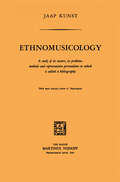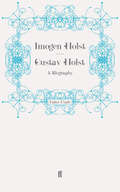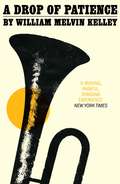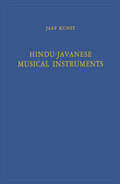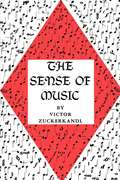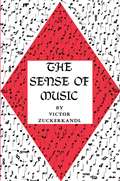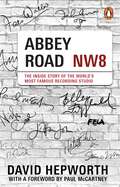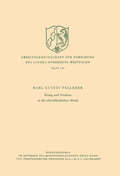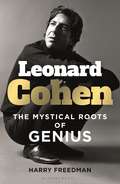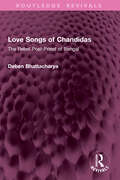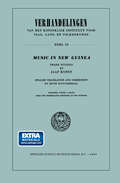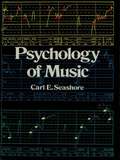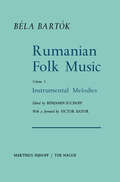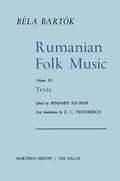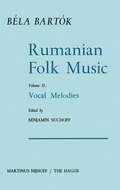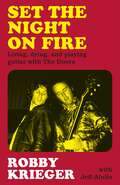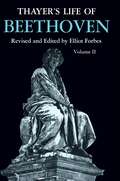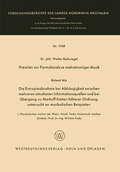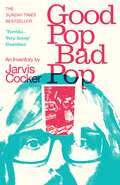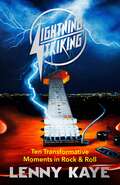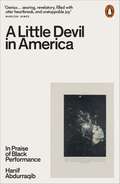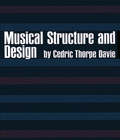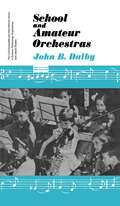- Table View
- List View
Ethnomusicology: A study of its nature, its problems, methods and representative personalities to which is added a bibliography
by Jaap KunstThis booklet hardly needs a preface; the contents, I think, speak for themselves. It contains a short and carefully brought up to date resume of all that I, as a private University Lecturer in Amsterdam, have tried to teach my pupils. It is intended as a general introduction to ethnomusicology, before going on to the study of the forms of separate music-cultures. I sincerely hope that those, who wish to teach themselves and to qualify in this branch of knowledge, will find a satisfactory basis for self tuition in the matter here brought together. Regarding the possibility of a new edition, any critical remarks or infor mation as to possible desiderata would be very gratefully received. J. K. PREFACE TO THE SECOND EDITION My request for critical remarks and desiderata has not been ignored. My sincere thanks to all who took the trouble to let me know what they missed in my booklet. Through their collaboration the contents have undergone a considerable improvement and enlargement as compared to the original edition issued in 1950 by the Royal Tropical Institute, Amsterdam, under the title 'Musicologica'. I have taken care to add many particulars from non-European sources, with the result that now the book is no longer so Europe-centric as it was.
Gustav Holst: A Biography
by Imogen HolstGustav Holst was a leading figure in the new age of English music in the late 19th and early 20th centuries. His most celebrated work, The Planets, is an orchestral tour de force, but he wrote music of startling originality in many forms, drawing inspiration from sources as varied as English folksong, oriental melody, the Apocrypha and Sanskrit literature, as well as from writers such as Keats, Hardy, Bridges and Whitman.This biography, by his daughter Imogen, was first published by Faber in 1938 and revised in 1969. In it she quotes at length from his many letters to his friends - especially to his closest colleague Vaughan Williams - and draws on her personal memories of Holst's later years.Holst struggled all his life against bouts of ill-health and depression, but his remarkable and good-humoured resilience enabled him to compose great music in often difficult circumstances. He was essentially a very private person, and the huge popular success of The Planets in 1919 disconcerted him. Imogen Holst describes the effect of this sudden fame on her father, and records the late flowering of his music in the final years of his life.
A Drop of Patience
by William Melvin KelleyAt the age of five, a blind African-American boy is handed over to a brutal state home. Here Ludlow Washington will suffer for eleven years, until his prodigious musical talent provides him an unlikely ticket back into the world.The property of a band, playing for down-and-outs in a southern dive, Ludlow's pioneering flair will take him to New York and the very top of the jazz scene - where his personal demons will threaten to drag him back down to the bottom.A Drop of Patience is the story of a gifted and damaged man entirely set apart - by blindness, by race, by talent - who must wrestle with adversity and ambition to generate the acceptance and self-worth that have always eluded him.
Hindu-Javanese Musical Instruments (Koninklijk Instituut voor Taal-, Land- en Volkenkunde)
by Jaap KunstThe Sense of Music
by Victor ZuckerkandlThis book is addressed to the listener whose enjoyment of music is filled with questions and whose curiosity makes him eager to grasp the sense of music, despite a lack of theoretical training. Unlike the usual listener's guide, which begins with a discussion of the elementary materials of music, this book starts with the elementary experiences of listening.
The Sense of Music
by Victor ZuckerkandlThis book is addressed to the listener whose enjoyment of music is filled with questions and whose curiosity makes him eager to grasp the sense of music, despite a lack of theoretical training. Unlike the usual listener's guide, which begins with a discussion of the elementary materials of music, this book starts with the elementary experiences of listening.
Spanian: The Unfiltered Hood Life
by SpanianBy the time he was twelve, Spanian knew he would follow his family's footsteps to become a career criminal. What followed was a decade-long string of brazen crimes and brutal violence: stabbings, ram-raids, drug runs and a notorious high school siege. Throughout the Sydney social housing enclaves of Redfern, Waterloo and Woolloomooloo, Spanian earned a reputation as one of the city's most flagrant crooks; armed with a boxcutter in one hand, and a syringe in the other.But it all came at a damning price: in the throes of heroin addiction and thirteen years wasted behind bars, Spanian became a longstanding resident of jails across New South Wales. There, he was embroiled in racial divisions, prison politics, and a vicious vortex of self-destruction, until music and books became an unlikely lifeline. Reading and rapping became new rituals, and a glistening light at the end of the tunnel. Released from Bathurst Correctional Centre in 2017 with newfound purpose, Spanian has since found viral fame and a sprawling, worldwide audience through hip-hop and his magnetic social media presence.This is the powerful, unflinching and high-octane memoir of how a young inner-city kid became Spanian. It gives unapologetic insight into the gritty socio-economic underbelly of Sydney city, the criminal justice system, and the correctional system. The story of Spanian provides hope that even the most stubborn cycles can be broken, and new dreams made.
Abbey Road: The Inside Story of the World’s Most Famous Recording Studio (with a foreword by Paul McCartney)
by David HepworthWith a foreword by Paul McCartney'We wanted to live the mystique of this legendary studio' Kanye West 'There are certain things that are mythical. Abbey Road is mythical' Nile RodgersMany people will recognise the famous zebra crossing. Some visitors may have graffitied their name on its hallowed outer walls. Others might even have managed to penetrate the iron gates. But what draws in these thousands of fans here, year after year? What is it that really happens behind the doors of the most celebrated recording studio in the world?It may have begun life as an affluent suburban house, but it soon became a creative hub renowned around the world as a place where great music, ground-breaking sounds and unforgettable tunes were forged - nothing less than a witness to, and a key participant in, the history of popular music itself.What has been going on there for over ninety years has called for skills that are musical, creative, technical, mechanical, interpersonal, logistical, managerial, chemical and, romantics might be tempted add, close to magic.This is for the people who believe in the magic.
Klang und Struktur in der abendländischen Musik (Arbeitsgemeinschaft für Forschung des Landes Nordrhein-Westfalen #141)
by Karl Gustav FellererLeonard Cohen: The Mystical Roots of Genius
by Harry Freedman'Leonard Cohen taught us that even in the midst of darkness there is light, in the midst of hatred there is love, with our dying breath we can still sing Hallelujah.' - The late Rabbi Lord Jonathan Sacks'Among the finest volumes on Cohen's life and lyrics ... An exploration which would have intrigued and engaged Leonard himself.' - John McKenna, writer and friend of Leonard CohenHarry Freedman uncovers the spiritual traditions that lie behind Leonard Cohen's profound and unmistakable lyricsThe singer and poet Leonard Cohen was deeply learned in Judaism and Christianity, the spiritual traditions that underpinned his self-identity and the way he made sense of the world. In this book Harry Freedman, a leading author of cultural and religious history, explores the mystical and spiritual sources Cohen drew upon, discusses their original context and the stories and ideas behind them.Cohen's music is studded with allusions to Jewish and Christian tradition, to stories and ideas drawn from the Bible, Talmud and Kabbalah. From his 1967 classic 'Suzanne', through masterpieces like 'Hallelujah' and 'Who by Fire', to his final challenge to the divinity, 'You Want It Darker' he drew on spirituality for inspiration and as a tool to create understanding, clarity and beauty. Born into a prominent and scholarly Jewish family in Montreal, Canada, Cohen originally aspired to become a poet, before turning to song writing and eventually recording his own compositions. Later, he became immersed in Zen Buddhism, moving in 1990 to a Zen monastery on Mount Baldy, California where he remained for some years. He died, with immaculate timing, on the day before Donald Trump was elected in 2016, leaving behind him a legacy that will be felt for generations to come. Leonard Cohen: The Mystical Roots of Genius looks deeply into the imagination of one of the greatest singers and lyricists of our time, providing a window on the landscape of his soul. Departing from traditional biographical approaches, Freedman explores song by song how Cohen reworked myths and prayers, legends and allegories. By the end the reader will be left with a powerful understanding of Cohen's story, together with a far broader insight into the mystical origins of his inimitable work.
Love Songs of Chandidas: The Rebel Poet-Priest of Bengal (Routledge Revivals)
First published in 1967, Love Songs of Chandidās provides an informative introduction which makes vividly clear the importance of Chandidās to the Indian peasant masses. As the author tells us, the traveller through the Birbhum area of Bengal hears Chandidās everywhere, in the villages, in the fields, on the roads. Night after night, the people gather in the temple courtyards or on the village greens to listen to professional ‘Kirtan’ singers sing his songs of the divine love of Radha and Krishna. The influence of Chandidās on contemporary Bengali literature is equally important, his songs having enriched the work of great poets such as Rabindranath Tagore, Govindadas, and many others. The author also discusses the interesting topic of the Sahaja (‘spontaneity’) movement in Indian faith and literature, as manifested in the songs of Chandidās, and the worship of love-making, divine and human, as an important aspect of this faith. This book will be of interest to students of literature, music, history, cultural studies and South Asian studies.
Love Songs of Chandidas: The Rebel Poet-Priest of Bengal (Routledge Revivals)
by Deben BhattacharyaFirst published in 1967, Love Songs of Chandidās provides an informative introduction which makes vividly clear the importance of Chandidās to the Indian peasant masses. As the author tells us, the traveller through the Birbhum area of Bengal hears Chandidās everywhere, in the villages, in the fields, on the roads. Night after night, the people gather in the temple courtyards or on the village greens to listen to professional ‘Kirtan’ singers sing his songs of the divine love of Radha and Krishna. The influence of Chandidās on contemporary Bengali literature is equally important, his songs having enriched the work of great poets such as Rabindranath Tagore, Govindadas, and many others. The author also discusses the interesting topic of the Sahaja (‘spontaneity’) movement in Indian faith and literature, as manifested in the songs of Chandidās, and the worship of love-making, divine and human, as an important aspect of this faith. This book will be of interest to students of literature, music, history, cultural studies and South Asian studies.
Music in New Guinea: Three Studies (Verhandelingen van het Koninklijk Instituut voor Taal-, Land- en Volkenkunde)
by Jaap KunstPsychology of Music
by Carl E. SeashoreBetween the physical world of vibration, as measured by apparatus, and the world of consciously heard music there is a third area of investigation. Our auditory apparatus and/or mind separates different instruments and tones, hears some vibrations but not others, adds tones to fill out the sound spectrum, etc. This middle ground is the province of the psychology of music, a subject about which even many physical scientists know little.This introduction, by the developer of the Seashore test of musical ability, is a thorough survey of this field, the standard book for psychologists specializing in the area, for the school, and for interested musicologists. It opens with the musical mind and with a series of chapters on music as a medium: vibrato, pitch, loudness, duration, timbre, tone, consonance, volume, and rhythm, dealing with each from the special point of view of the role of psychology. It then moves to such factors as learning, imagining, and thinking in music; the nature of musical feeling; the relative sound patterns of specific instruments and the human voice; measures of musical talent; inheritance of musical ability; primitive music; the development of musical skills; and musical aesthetics.This wealth of material is supplemented with dozens of oscillograms and other sound-pattern charts recorded from actual play and singing by Jeritza, Caruso, Paderewski, Szigeti, Rethberg, Menuhin, Martinelli, and other artists. An appendix cites two attitudes toward the evaluation of musical talent and over 200 bibliographic references.
Rumanian Folk Music: Instrumental Melodies (Bartok Archives Studies in Musicology #1)
by Bela Bartokn several of his writings on folk music Bela Bart6k recalls an incident I that happened to him in 1904 during a visit to a small village in Tran 1 syl vania. Quite by chance he heard there an eighteen-year-old Hun garian peasant girl singing Hungarian folk songs whose construction was 2 significantly different from the songs he had known until then. This experience appealed to his imagination far deeper than chance oc currences usually do. It sparked in him a creative fire that was there after to impart to his music certain characteristics that are recognizable today as indigenous to the Bart6kian style of composition. The inspirational value of the incident was rekindled by return trips to Transylvania. During these trips he was not merely listening. He began notating, melodies, building them into a coordinated collection. Soon Bart6k's itinerary took him into villages populated in checkered proximity by both Hungarians and Rumanians, thence into little communities where the population was exclusively Rumanian. There he discovered that their songs were much less, if at all, influenced by the urban civilization of Western Europe than those he had collected in Hungarian villages. In an interview he gave to a Transylvanian newspaper in 1922, Bart6k described the difference between the available Hungarian and Rumanian songs.
Rumanian Folk Music: Texts (Bartok Archives Studies in Musicology #3)
by Bela BartokN January 30, 1944, Bela Bart6k, writing from Asheville, North O Carolina, where he had gone to regain his strength after a long period of ill-health in 1943, commented, Here I have started on a very interesting (and, as usual, lengthy) work, the kind I have never done before. Properly speaking, it is not a musical work: I am arranging and writing out fair copies of Rumanian folksong texts'! Although the date has not as yet been established, the first draft of the Rumanian folk texts as texts per se was written-if an apparent age of the MS. can be considered a clue-sometime before Bartok had emigrated to the United States in 1940. This draft (see description below) had been forwarded for etymological data, according to the non-Bart6kian autography appearing thereon. The identity of the informant or informants involved and the circumstances surrounding this matter remain unknown at the present writing. After Bart6k had made offset prints of the music examples of the 2 first two volumes of Rumanian F olk Music in 1940, the printed but incomplete draft of Vol. II (Vocal Melodies)-comprising 304 of the ultimate total of 659 pages-was sent to Nicholas Vama~escu, then di rector of "The Romanian Radio Hour" (Station W. ]. L. B. , Detroit, 3 Michigan), for correction of the texts, in April, 1941. 1 Letter to Joseph Szigeti, in Bartok Bela levelei (ed. Janos Demeny; Budapest: Miivelt Nep Konyvkiado, 1951), p. 184.
Rumanian Folk Music: Vocal Melodies (Bartok Archives Studies in Musicology #2)
by Bela Bartokhe editorial treatment of the second volume of Bela Bart6k's T Rumanian Folk Music is not dissimilar to that applied to Vol. I. The matter of poetic texts here, however, must allow for a sizeable increase in corrigenda and addenda. But first, let us delve into the source material upon which Vol. II is based. THE MANUSCRIPTS The various drafts of Vol. II fall into five basic categories of editorial process: music, texts, notes to the melodies (and texts), preface, and 1 miscellaneous reference material. M usic.-The first draft comprises field recording transcriptions, and notations made on the spot when recording was not possible. Bart6k left behind the bulk of this material when he emigrated to the United States in October, 1940 (The complete poetic text appears together with the music in each transcription).2 The second draft, uncorrected, comprises 304 pages printed by photo 3 offset process from master sheets. The third draft, reproduced from 667 pages of master sheets, is 1 All are contained in the New York Bartok Archives (hereinafter referred to as the BA) in envelopes designated by the author as Nos. 82-83, 85-86, 88, 90-97, 100, 102, and 106-107. See fn. 12 of the editorial Preface to Vol. I for the complete listing of the Rumanian folk' music MS.
Set the Night on Fire: Living, Dying and Playing Guitar with the Doors
by Robby KriegerFew bands are as shrouded in the murky haze of rock mythology as The Doors, and parsing fact from fiction has been a virtually impossible task. But now, after fifty years, The Doors' notoriously quiet guitarist is finally breaking his silence to set the record straight.Through a series of vignettes, Robby takes readers back to where it all happened: the pawn shop where he bought his first guitar; the jail cell he was tossed into after a teenage drug bust; his parents' living room where his first songwriting sessions with Jim Morrison took place; and the many concert venues that erupted into historic riots.Robby also goes into heartbreaking detail about his life's most difficult struggles, ranging from drug addiction to cancer, but he balances out the sorrow with humorous anecdotes about run-ins with unstable fans, famous musicians, and one really angry monk. SET THE NIGHT ON FIRE is at once an insightful time capsule of 1960s counterculture and a moving reflection on what it means to find oneself as a musician. It's not only a must-read for Doors fans, but an essential volume of American pop culture history.
Thayer's Life of Beethoven, Part II
by Elliot ForbesAlexander Wheelock Thayer's Life of Beethoven. has long been recognized as the classic biography of Beethoven. "Thayer, with his calm and logical mind, scrupulous, magnanimous and spacious...had set out to describe for posterity the great man as he was and lived...and his patient realism and all but inexhaustible industry had created an irreplaceable and masterly portrait." So Van Wyck Brooks described this monumental work of the 1880's.Thayer talked with Beethoven's surviving friends, gathered anecdotes, and sifted hundreds of documents. The resulting wealth of detail stimulated other students, and a mass of Beethoven scholarship appeared. Now Elliot Forbes, one of the foremost Beethoven scholars of our time, has used this new material to bring the Life up to elate without sacrificing Thayer's text.
Theorien zur Formalanalyse mehrstimmiger Musik: Die Entropieabnahme bei Abhängigkeit zwischen mehreren simultanen Informationsquellen und bei Übergang zu Markoff-Ketten höherer Ordnung, untersucht an musikalischen Beispielen (Forschungsberichte des Landes Nordrhein-Westfalen #1768)
by Walter ReckziegelDer vorliegende Bericht stützt sich auf die Arbeiten von WILHELM PUCKS und baut auf den Methoden und Ergebnissen des genannten Autors auf. Die Kenntnis der im Verzeichnis angeführten Literatur darf vorausgesetzt werden. Die im Text erwähnten statistischen Begriffe (Mittelwert, Streuung etc. ) wurden von FUCKS zur Untersuchung musikalischer Elemente benutzt. Er stellte eine Reihe von Analysen an, indem er zunächst die relative Häufigkeit der Tonhöhen einstimmiger Melodien (Violin- und Flötenstimmen, Gesangs-Oberstimmen aus klassischen Werken von etwa 1500 bis heute) berechnete. Es wurde gezeigt, daß die Streuung und die Entropie der Zahlenwerte unabhängig voneinander proportional zur Entstehungszeit der Musik monoton ansteigen. Sodann wurden Intervalle zwischen je zwei benachbarten Tönen gebildet und ebenfalls deren Häufigkeit ausgezählt. Da hier die Streuung wegen der qualitativen Gleichheit oktavversetzter Töne als Hilfsmittel unbrauchbar ist, wurde die Kyrtosis der Zahlenwerte be rechnet. Trägt man die erhaltenen Werte wieder als Punktion der Zeit auf, so erfolgt nur zum Teil ein monotoner Anstieg; eine Gruppe von Zwölftonkompo sitionen dagegen sinkt auffallend tief, sogar noch unter die Werte der Barockzeit und der franko-flämischen Periode, ab. Die sog. Tonhöhenübergangsmatrix in den erwähnten Arbeiten gibt ein anschau liches Bild davon, welche Töne jeweils aufeinander folgen. Vergrößert man den Abstand zwischen den benachbarten Elementen schrittweise um 1, so kann für jeden Abstand q eine weitere Matrix aufgestellt werden. Die Übergangsmatrizen q-ter Ordnung lassen sich durch Korrelationsellipsen ersetzen, die zwischen den Grenzfällen »Parallele Geraden« und »Kreis« alle möglichen Formen annehmen können. Dasselbe Verfahren läßt sich auch auf Intervallpaare anwenden.
Good Pop, Bad Pop: The revealing and original new memoir from Jarvis Cocker
by Jarvis Cocker**AS HEARD ON BBC RADIO 4 BOOK OF THE WEEK**What if the things we keep hidden say more about us than those we put on display?We all have a random collection of the things that made us - photos, tickets, clothes, souvenirs, stuffed in a box, packed in a suitcase, crammed into a drawer. When Jarvis Cocker starts clearing out his loft, he finds a jumble of objects that catalogue his story and ask him some awkward questions: Who do you think you are? Are clothes important? Why are there so many pairs of broken glasses up here? From a Gold Star polycotton shirt to a pack of Wrigley's Extra, from his teenage attempts to write songs to the Sexy Laughs Fantastic Dirty Joke Book, this is the hard evidence of Jarvis's unique life, Pulp, 20th century pop culture, the good times and the mistakes he'd rather forget. And this accumulated debris of a lifetime reveals his creative process - writing and musicianship, performance and ambition, style and stagecraft. This is not a life story. It's a loft story.
Lightning Striking
by Lenny Kaye'A true testimonial and epic love letter to the soul saving power of rock & roll . . . Read it and be inspired, as I was' Bobby Gillespie'Lenny Kaye has illuminated ten facets of the jewel called rock and roll from a uniquely personal and knowledgeable perspective. He draws from a lifetime of inspiration and experience. A youth plugging in his first electric guitar, a fan taking the dance floor, a propelling player, a humble guardian of history, and the writer I have always known him to be' Patti SmithMemphis, 1954. New Orleans 1957. Philadelphia 1959. Liverpool, 1962. San Francisco 1967. Detroit 1969. New York, 1975. London 1977. Los Angeles 1984 / Norway 1993. Seattle 1991.Rock and roll was birthed in basements and garages, radio stations and dance halls, in cities where unexpected gatherings of artists and audience changed and charged the way music is heard and celebrated, capturing lightning in a bottle. Musician and writer Lenny Kaye explores ten crossroads of time and place that define rock and roll, its unforgettable flashpoints, characters and visionaries, how each generation came to be, how it was discovered by the world. Whether Elvis Presley's Memphis, the Beatles' Liverpool, Patti Smith's New York or Kurt Cobain's Seattle, LIGHTNING STRIKING reveals the communal energy that creates a scene, a guided tour inside style and performance, to see who's on stage, along with the movers and shakers, the hustlers and hangers-on, and why everybody is listening. Grandly sweeping and minutely detailed, informed by Kaye's acclaimed knowledge and experience as a working musician, LIGHTNING STRIKING is an ear-opening insight into our shared musical and cultural history, a carpet ride of rock and roll's most influential movements and moments.
A Little Devil in America: In Praise of Black Performance
by Hanif AbdurraqibAn electrifying celebration of Black performances, cultures and communities in the United States, from the New York Times bestselling poet and critic Hanif Abdurraqib'Gorgeous' - Brit Bennett'Pure genius' - Jacqueline Woodson'One of the most dynamic books I have ever read' - Clint SmithAt the March on Washington, Josephine Baker reflected on her life and her legacy. She had spent decades as one of the most successful entertainers in the world, but, she told the crowd, "I was a devil in other countries, and I was a little devil in America, too". Inspired by these words, Hanif Abdurraqib has written a stirring meditation on Black performance in the modern age, in which culture, history and his own lived experience collide.With sharp insight, humour and heart, Abdurraqib explores a sequence of iconic and intimate performances that take him from mid-century Paris to the moon -- and back down again, to a cramped living room in Columbus, Ohio. Each one, he shows, has layers of resonance across Black and white cultures, the politics of American empire, and his own personal history of love and grief -- whether it's the twenty-seven seconds of 'Gimme Shelter' in which Merry Clayton sings, or the magnificent hours of Aretha Franklin's homegoing; Beyoncé's Super Bowl show or a schoolyard fistfight; Dave Chapelle's skits or a game of spades among friends.
Musical Structure and Design
by Cedric T. DavieCedric Thorpe Davie is himself a noted composer, and musical forms are as familiar to him as armatures are to the sculptor. As a result, he is able not only to describe them clearly, but also to evaluate their qualities and to point out their truly characteristic fundamentals. It is his discussions of such core questions as: What is the true basis of sonata form? And What are the qualities of a successful form that make for convincing music? that cause his book to be the unusually interesting and lively study that it is.The text defines and describes the forms commonly used by Western composers in the period between 1550 and 1900. These are the binary and ternary forms, including the de capo aria, minuet-and-trio, and rondo; the sonata form; the forms in the concerto; variation forms -- including ground bass, passacaglia, and chaconne; and the contrapuntal forms, notably the fugue and canon. Each form is illustrated with a detailed analysis of a specific piece or movement, usually from the work of Bach, Haydn, Mozart, or Beethoven, but often from Purcell, Brahms, Dvorak, or other composers. The student is also referred to a list of compositions in the same form for further study.Experienced musicians, both professional and amateur, and students will find the author's thoughtful, well-written discussions of the controversial aspects of formal analysis extremely perceptive and stimulating. Beginning music lovers, even those with little or no training in music, will come away from a thorough reading of the book with a good knowledge of each important musical form, and with a greatly increased insight into the way music is organized.
School and Amateur Orchestras: The Commonwealth and International Library: Music Division
by John B. DalbySchool and Amateur Orchestras is devoted to a discussion of school and amateur orchestras and consideration of instruments that are normally associated with them. The book opens with a general discussion of students, teachers, music centers, and junior music schools. This is followed by separate chapters on the teaching of string, woodwind and brass, and percussion instruments. Subsequent chapters deal with the planning and direction of orchestras and the selection of instruments and music.
